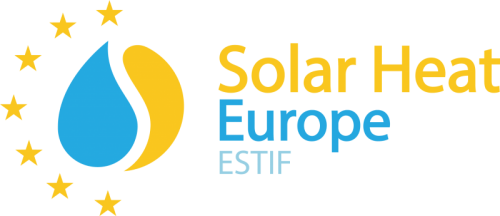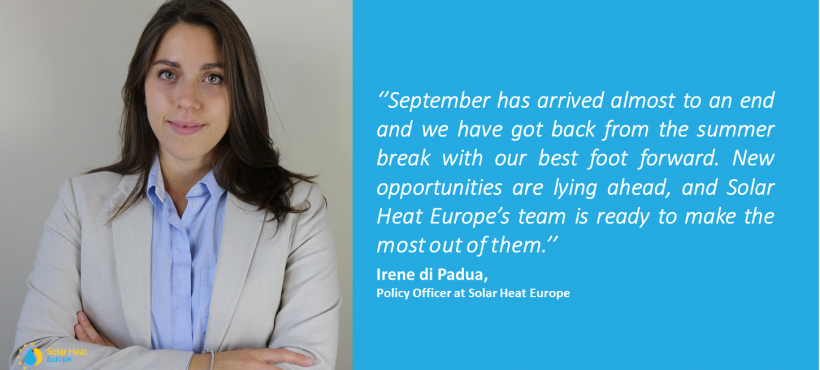September has arrived almost to an end and we have got back from the summer break with our best foot forward. New opportunities are lying ahead, and Solar Heat Europe’s team is ready to make the most out of them.
The aftermath of the COVID19 outbreak
These last months were not easy for anyone. The Covid19 pandemic outbreak brought us to rethink several aspects in our lives, from our workspace to our relations with others. Everything was impacted by a crisis that goes far beyond health and which consequences are expected in the foreseeable future.
A call for action from the whole solar thermal sector
To face this unprecedented challenge, the solar thermal sector got together in a clear statement of its commitment in achieving a recovery which is also aligned with our climate and energy goals. In this call for action to #SolariseHeat we published the European Solar Thermal Industry Pledge. This initiative involves more than 200 entities from private and public actors active in the solar thermal field and went beyond European borders engaging signatories from 28 countries.
Stronger together
The success of the pledge was a joint effort addressing media and policymakers, not just in Brussels, but also, and in particular, at the national and local level. This could not have happened without the engagement of our national associations which were a key enabler in spreading the news locally. To further attract signatories, the pledge was also translated in Dutch, German, Greek, French, Spanish, and Polish.
This initiative has proven to be a key tool to promote the role of Solar Thermal not just at European but also at the national level. This is a mean to showcase the strength and commitment of the sector, but also advocate for better political and financial recognition.
With the due support, the solar thermal industry is ready to strive even more, and the pledge can be an enabler of this transformation.
The Recovery and Resilience Facility
To cope with these challenging times, the European Commission launched Next Generation EU. Part of it includes the Recovery and Resilience Facility, a temporary instrument to increase the support from financial markets and promote a special focus on green and digital issues.
In this context, the Commission investigated projects in the pipeline that could benefit from this facility and published the Annual Sustainable Growth Strategy 2021. This is a once in a lifetime opportunity to get access to additional funding and visibility for solar thermal.
Building a case for solar thermal
Consequently, Solar Heat Europe collected inputs to showcase the diversity of solar thermal projects to build a case on our technology and show the need for additional investments in this field. The examples range from small-scale individual applications to large-scale district networks and industrial uses in several sectors, showing how solar heat can be used in different member states and climate conditions, and that is not limited to a single type of application.
This database will be used to provide input and (later) feedback to National Recovery Plans, that the Member States are preparing and shall start delivering to the Commission from mid-October onwards.
A higher ambition for energy and climate
As announced by Ursula Von der Leyen in her first State of the European Union address, the EU is raising its ambition to achieve climate neutrality by 2050. The President of the Commission confirmed the target of -55% for emissions reduction by 2030 but heating and cooling is still not getting the attention it needs.
In this context, it will be fundamental to have a strong reaction from the solar thermal sector on the reopening of two key directives: The Renewable Energy (RED II) and the Energy Efficiency (EED).
Policy files…do not miss these ones!
Now that a new target for GHG emissions is on the table, this must go along with higher ambition for renewables and energy efficiency, and additional focus needs to be given to renewable heat. Solar Heat Europe will advocate for an obligation on setting up a support mechanism and mandatory national targets to increase the share of locally produced renewable heat sources.
The Renovation Wave is expected to be presented in October and it will need to keep a comprehensive approach, including actions to modernise old and inefficient heating and cooling systems, and further support the switch to renewables.
Finally, the Commission is likely to continue the discussion on energy storage started by the European Parliament with its own initiative report. There it will be essential to bring the contribution of solar thermal in the debate and stress the relevance of thermal energy storage as a key policy and technology enabler.
And what is next?
The upcoming month will be busy with new policy initiatives already mentioned and the implementation and follow up from previous legislative files. For this, we are preparing as well as possible and we will stay open to new partnerships and raising opportunities. Our objective is to have solar thermal well present in the European agenda, acting through different channels and connecting with different actors to further spread our messages.
Additionally, next year will also represent an opportunity to bring a new dynamic to R&I for solar thermal. The new Horizon Europe calls for 2021-2022 will be launched, together with several partnerships that will integrate this framework programme. It will also be the year of the ESTTP (the EU Solar Thermal Technology Panel) presidency of the RHC-ETIP. This will be an opportunity to reaffirm the importance of research and innovation in the deployment of solar thermal applications, and how cross-sectoral initiative, such as the RHC platform can bring further attention to renewable heating and cooling.
In brief, this winter will all have to roll up our sleeves and work together on a better future for solar thermal.


Leave a Reply